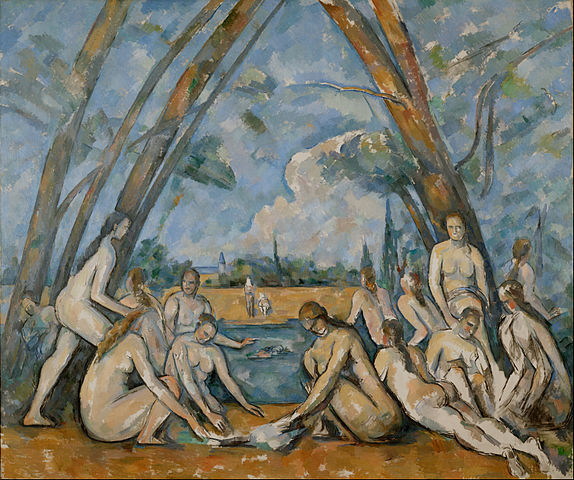
Name: The Large Bathers
Artist: Paul Cézanne
Date Painted: 1898 – 1905
Period: Impressionism
Dimensions: 210.5 cm (h) x 250.8 cm (w)
Medium / Material: Oil on Canvas
Current Location: Philadelphia Museum of Art, USA
Introduction
“The Large Bathers” (Les Grandes Baigneuses) by Paul Cézanne is a monumental work that encapsulates the transition from 19th-century Impressionism to the early 20th-century Cubism and beyond, influencing the direction of modern art. Created towards the end of Cézanne’s life, between 1894 and 1905, this painting is one of several Bathers series, showcasing his lifelong fascination with the theme. It’s housed in the Philadelphia Museum of Art and stands as a testament to Cézanne’s innovative approach to form, composition, and the depiction of space and the human figure.
Composition and Theme
The painting depicts a group of nude female figures bathing in a serene, timeless landscape. The figures are arranged in a loosely triangular formation, anchored by trees and framed by a sky and distant landscape that seem to converge towards the center of the composition. This central grouping within the landscape creates a harmonious balance between human figures and the natural world, a recurring theme in Cézanne’s work.
Technique and Style
Cézanne’s technique in “The Large Bathers” is characterized by his use of broad, flat planes of color and deliberate, geometric brushstrokes that build up the form and volume of the figures and landscape. He moves away from the traditional perspective, flattening the space and treating the figures and background with equal importance. This approach breaks down the conventional hierarchy of figure and ground, allowing for a more dynamic interplay between the two.
The use of color in this painting is subtle yet complex, with cool blues and greens dominating the composition, punctuated by warm tones of the figures’ skin. This careful balance of colors enhances the serene and timeless atmosphere of the scene.
Influence on Modern Art
“The Large Bathers” is considered a cornerstone in the development of modern art. Cézanne’s departure from realistic representation and his exploration of geometric simplification and abstraction influenced generations of artists. His method of building forms with color and his reduction of natural figures and landscapes to their geometric essentials paved the way for Cubism, led by artists like Pablo Picasso and Georges Braque, who saw Cézanne as a forefather of their movement.
Interpretation
Interpretations of “The Large Bathers” vary, with some viewing it as a celebration of natural beauty and harmony between humans and nature, while others see it as an exploration of form and color that transcends subject matter. Cézanne’s figures are not individualized but rather idealized forms that serve his study of composition and the relationships between shapes on the canvas.
The painting’s lack of narrative and its focus on structural and spatial analysis highlight Cézanne’s departure from traditional storytelling in art, emphasizing instead the painting’s formal qualities. This shift reflects the artist’s belief in the primacy of painting as an autonomous medium with its own language, independent of its ability to represent the world.
Conclusion
“The Large Bathers” is not just a culmination of Cézanne’s artistic explorations but also a groundbreaking work that challenged conventional approaches to painting and anticipated the radical changes of modern art. Through this masterpiece, Cézanne articulated a new visual language that would profoundly impact the trajectory of art in the 20th century, making it a pivotal work in the history of Western art.